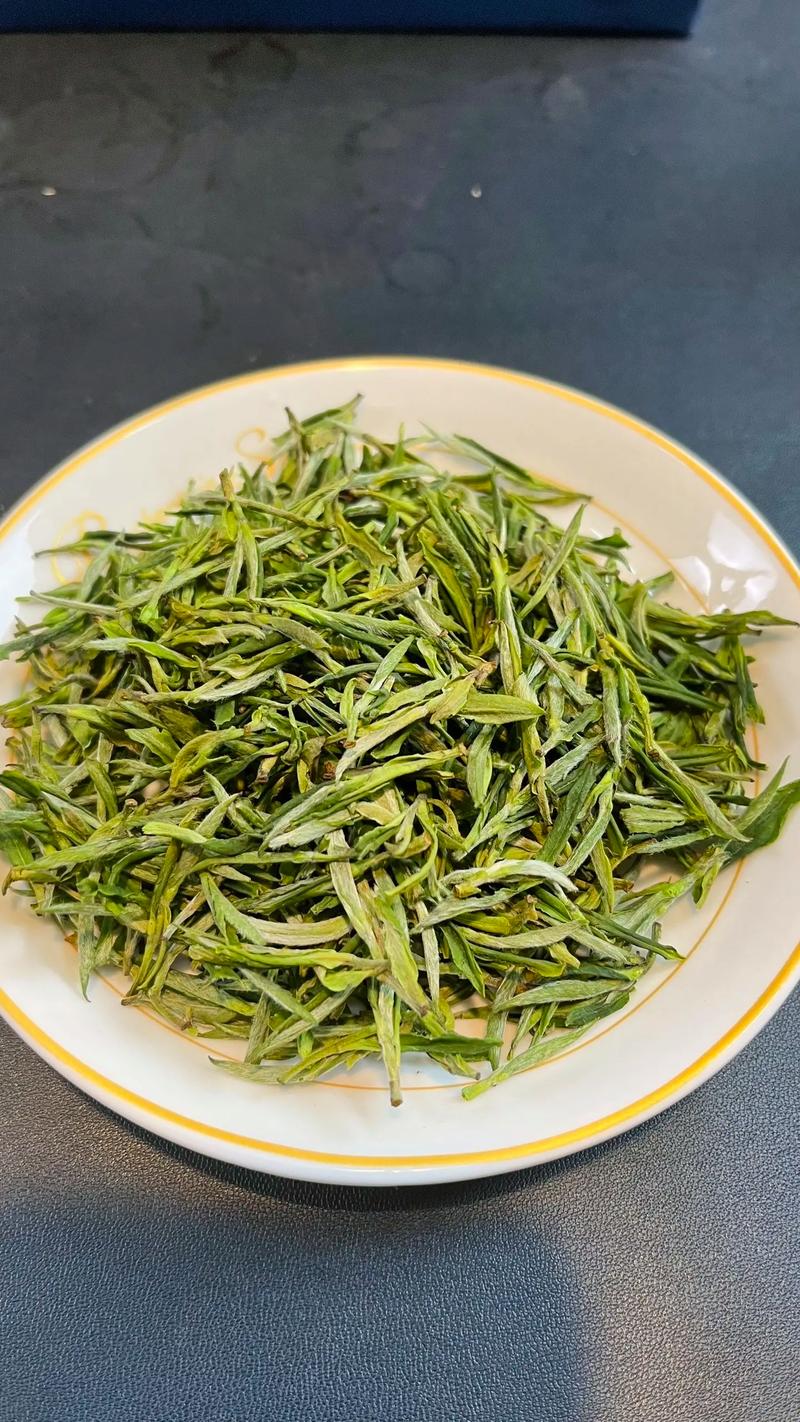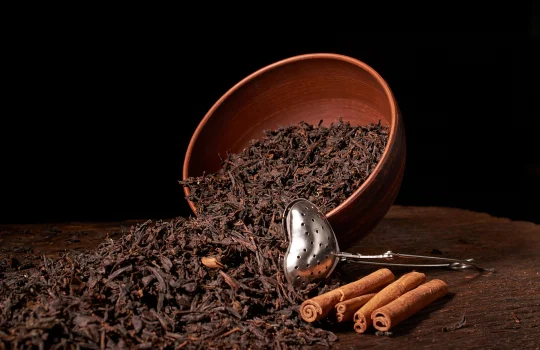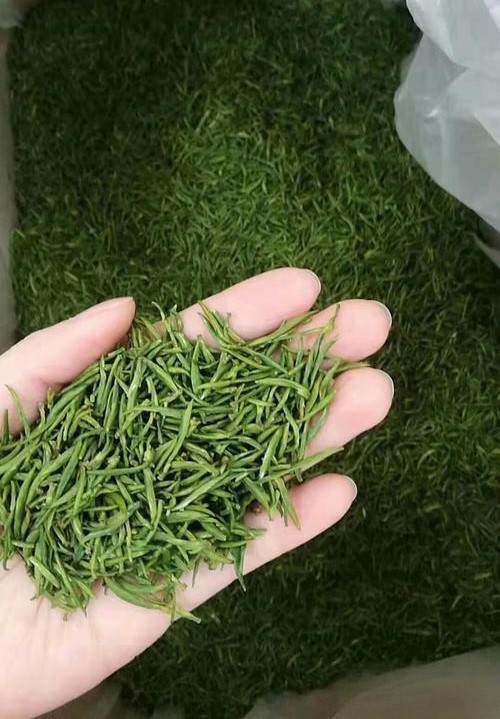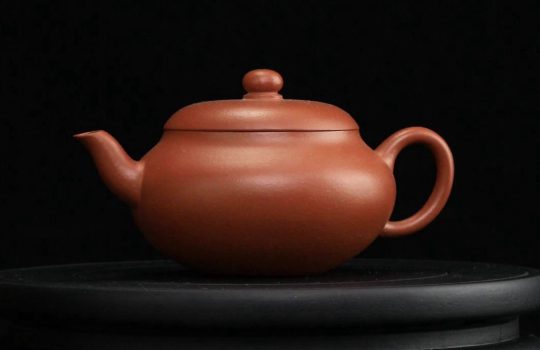Place of Origin: Huangshan, Shexian County, Anhui Province.
Quality Characteristics: The tea leaves are slender, flat, and slightly curled, resembling ‘sparrow’s tongues,’ with silver tips clearly visible, and buds resembling ‘sharp peaks.’
Tea Colour: Clear, greenish-yellow.
Taste: Sweet, mellow, fresh, and crisp, with a lingering sweet aftertaste.
Tea Leaves: Yellow-green, fresh, and tender, forming uniform clusters.
Detailed Introduction to Huangshan Mao Feng
Huangshan Mao Feng is one of China’s famous historical teas, created by the Xie Yutai Tea House during the Guangxu period of the Qing Dynasty. The newly produced tea leaves are covered in silver hairs, with sharp tips, and the fresh leaves are harvested from the peaks of Huangshan Mountain, hence the name Huangshan Mao Feng. As the saying goes, ‘good mountains and good water produce good tea.’ Xu Cizhu, a tea master from the Ming Dynasty, wrote in his book ‘Tea Treatise’ that ‘famous mountains must produce fine tea.’ The areas around Taohua Peak, Ziyun Peak, Yunju Temple, Songgu An, Diaoqiao An, and Ciguang Pavilion in the Huangshan Scenic Area are lush with forests, shrouded in mist, and warm and humid. This unique climate provides excellent natural conditions for the growth of Huangshan Maofeng.
The taste of Huangshan Mao Feng
It has a fresh and rich flavour, smooth and elegant, with a sweet aftertaste. The fragrance of white orchids lingers on the palate, and the subtle sweetness persists for a long time.
Detailed description of the appearance of Huangshan Mao Feng
High-quality Huangshan Mao Feng resembles sparrow’s tongues, with visible white downy hairs, an ivory-like colour, and buds and leaves forming clusters that are thick and vibrant. The two most distinctive features of top-grade Huangshan Mao Feng compared to other Mao Feng teas are the ‘golden fish leaves’ and the ‘ivory-like colour.’ Authentic tea, when brewed, emits a fresh and lingering aroma, with a clear broth, a fresh, rich, mellow, and sweet taste, and tender yellow leaves that are plump and form clusters. Counterfeit tea often contains artificial colouring, appearing earthy yellow in colour, with a bitter, astringent, and weak taste, irregularly shaped leaves, and leaves that do not form clusters.
Storage of Huangshan Mao Feng
Keep sealed and moisture-proof to prevent excessive moisture, which can cause mould. Avoid exposing Huangshan Mao Feng to items with strong odours. Do not store Huangshan Mao Feng in high temperatures, as high temperatures accelerate oxidation of the tea leaves. When storing Huangshan Mao Feng, avoid exposure to light to prevent degradation of the active components in the tea leaves.
Health Benefits of Huangshan Maofeng
Diuretic and anti-edema: The caffeine and theophylline in tea have diuretic and detoxifying effects, and can be used for conditions such as edema, urinary retention, and acute jaundice-type hepatitis.
Preventing tooth decay: Tea contains fluoride, which has a strong affinity with the calcium in teeth, forming a more acid-resistant ‘fluorapatite,’ akin to a protective layer that enhances teeth’s resistance to acid and tooth decay. Anti-cancer: The flavonoids in tea have varying degrees of anti-cancer effects in vitro, with stronger effects observed in compounds such as oleuropein, morin, and catechins.
A Story About Huangshan Mao Feng
During the Tianqi era of the Ming Dynasty, the newly appointed county magistrate of Yixian County in Jiangnan, Xiong Kaiyuan, brought his servant to Huangshan for a spring outing. They got lost and encountered an old monk carrying a bamboo basket, so they stayed overnight at the monastery. When the monk brewed tea for his guest, the magistrate noticed that the tea leaves were slightly yellow in colour, shaped like sparrow tongues, and covered in white downy hairs. When hot water was poured over them, steam swirled around the edge of the bowl, then rose straight up to about a foot in height, circled in the air, and transformed into a white lotus flower. The white lotus flower slowly rose again, transforming into a cloud of mist, which eventually dispersed into wisps of steam drifting throughout the room, filling it with a fragrant aroma. The magistrate inquired and learned that the tea was called Huangshan Mao Feng. Before parting, the monk gifted him a packet of the tea and a gourd of Huangshan spring water, instructing him that only by using this spring water to brew the tea would the miraculous white lotus phenomenon occur. Later, the emperor heard of this miraculous sight and summoned Xiong Kaiyuan to the palace to brew tea. After witnessing the white lotus spectacle, the emperor smiled broadly and said to Xiong, the county magistrate, ‘I commend you for your contribution in presenting this tea. I hereby promote you to Governor of Jiangnan. You shall assume your new post in three days.’ Xiong felt deeply moved and reflected, ‘If even the renowned Huangshan tea possesses such noble qualities, how much more so should a person strive for such virtue?’ He then removed his official robes and jade sash, went to the Yunju Temple on Huangshan Mountain, and became a monk, taking the Dharma name Zhengzhi. Today, along the path beneath the Yunju Temple, where cypress trees reach the clouds and bamboo groves line the way, there is the site of the tomb tower of Master Yibian, which is said to be the grave of Monk Zhengzhi.




